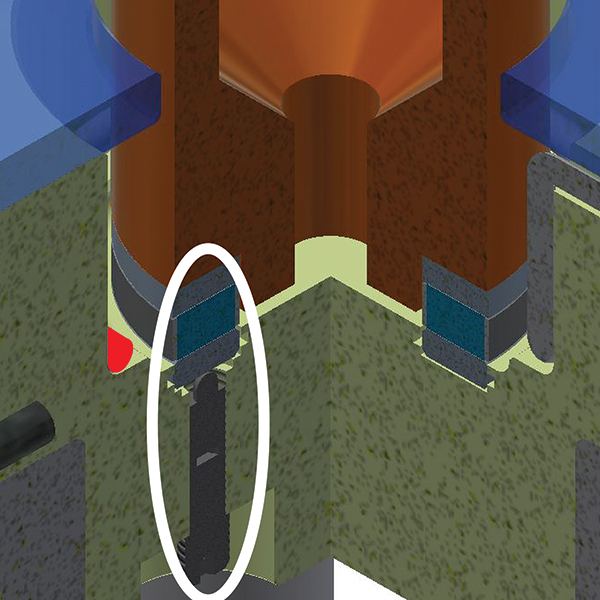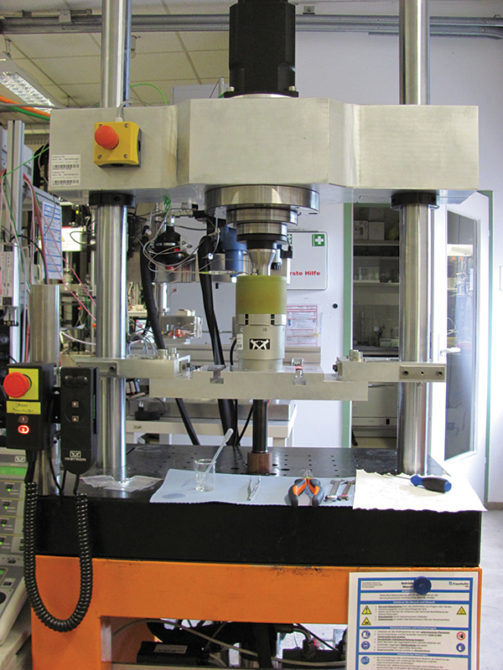
“Wind turbines are tribology labs on sticks,” Jim Carey said, quoting his former ExxonMobil colleague and former STLE President Martin Webster. Carey spent more than 20 years of his career at Mobil and ExxonMobil as principal formulator of wind turbine fluids.
But even after copious amounts of work overcoming major failures in the gearboxes and bearings, wind turbine failures are still common. Could a lubricant that utilizes an amount of the electricity generated in the turbine become the next tool to protect vital parts?
In the wide landscape of industrial lubricants, those for wind turbines probably attract the most attention. Most people agree that the two dominant sources of renewable energy for the foreseeable future will be solar and wind. But as most solar photovoltaic panels are fixed—and are the most prevalent form of solar energy generation—the focus for lubricants is on wind turbines.
Locations with predictable winds are, by definition, exposed. They are typically located on high ground or at sea and are remote from population centers. They usually face one or more temperature extremes (diurnal and annual) or high humidity (at sea, in clouds or in areas of high precipitation). Those in the clouds face static charges and electrical discharges. Access for maintenance and repair can be difficult. Even the most predictable winds change direction and have varying strength. Sometimes the grid doesn’t want the energy being produced, which can lead to sudden stops or return currents via the generators.
The challenge for lubricants includes but is not limited to high and varying loads, stop-start or fast-slow operation, constant buffeting and vibrations, long service lives, electrical charges, water ingress and temperature fluctuations.
Early Failures
The earliest commercial wind turbines for electricity generation were based on conventional industrial motors switched around to become generators and therefore using contemporary gearbox lubricants. “We were dealing with unoptimized lubricants in machines they weren’t designed for,” Carey told Lubes’n’Greases.
Initial focus was on scuffing on the high-speed bearing, for which specifications still exist 25 years later. Then focus changed to the low-speed side. “You have the wind rocking things back and forth, precessional movements of the blades pushing and pulling the top of the tower. All the 1-2 Hertz of heavy vibrations affected the health of the machine,” Carey said.
It’s the Micropits!
As turbines got bigger and loads increased, micropitting of gear teeth became a significant issue. The damage occurred at the roots of the gear teeth, resulting in catastrophic failure as gear teeth snapped off. Tribological studies showed that the micropitting began with surface stresses, which led to horizontal sub-surface cracks and spalling, which created shallow pits. The gears at this time were case hardened. Carey described this as “like Klondike Bars,” a confection where a hard chocolate shell encases a soft ice cream. “Once you violate the hard outer shell [with the micropits], the soft matrix makes it very easy to tear the gear tooth right off in a rolling contact,” he explained.
Another cause of damage to the hardened exterior was denting due to high backlash. Tighter design and manufacturing tolerances reduced backlash, and smoother gear teeth polished their counterparts during running in, reducing surface stresses.
There were also lubrication solutions, including—perhaps counterintuitively—reducing anti-wear additive concentration. Adding friction modifiers appeared to have the same effect. “The use of friction modifiers slows down the formation of the anti-wear film and allows the gear teeth to be polished,” said Marc Ingram, principal consultant at Ingram Tribology in Carmarthen, Wales. “The formulator’s focus is on reducing surface stress.”
In addition to low-friction additives (or thin and smooth anti-wear films), Ingram added that “formulators can use low-traction base oils, such as PAOs, to reduce the stress on the surface further.”
Carey and his colleagues also sought to explain the role of the base fluid. “At the point when the motion of the pinion and the wheel transitions from sliding to rolling, the base fluid experiences a tremendous pressure rise,” he said. “We believe this causes a glass to form momentarily, which can propagate dents, scuffing, and in effect allow metal-to-metal contact with high temperatures.”
Hydrocarbon base fluids with stable, very high viscosity index, such as metallocene PAOs, can avoid this issue and continue to flow under these conditions. However, it is their pressure-viscosity characteristics that favor flow at the operating pressures, not their VI (viscosity-temperature).
Don’t Fret
In low wind, when the blades are not rotating, vibrations due to rocking and rotation led to fretting wear on the main bearings, as the weight of the blades and the main shaft were supported on a very small contact patch from which the lubricant had been squeezed.
One of the most successful evolutions of wind turbine design to eliminate low-frequency vibrations was the move to the now ubiquitous three blades. Carey refers to this as “the Danish design.” With no opposed blades, yawing (side to side) movements are minimized. Tighter engineering tolerances that eliminated backlash removed many rotational vibrations. “A 3-legged stool is always balanced,” he said.
White Etching Cracking
At the start of the last decade, white etching cracking—known as WEC—began appearing in bearings of wind turbine gearboxes that were failing well within their design life. “The L10 life—where you would expect 10% to fail—is around 20 years in a wind turbine gearbox,” Ingram said. Field failures were being observed after just two to three years. Many failures were associated with multiple pits and multiple axial cracks. Metallurgical studies revealed extensive networks of sub-surface cracks that show up as bright white when treated with a solution of nital (nitric acid in alcohol).
“Thankfully, people appear to have identified the main mechanisms of WEC formation,” Ingram said. “These include hydrogen ingress into the steel, stray currents, water in the oil and the transient running conditions (loads and speeds). To form them in the lab, you must have some kind of accelerant. People have shown WEC with each one of these four main accelerants.”
Ingram’s reference to stray currents brings electrochemistry into play.
Carey said that he is “convinced that all white etching cracking is hydrogen embrittlement.” He and co-authors at ExxonMobil and the bearing manufacturer Schaeffler published results in 2018 showing that water trapped in the tribolayer (from hygroscopic additives) was the source of hydrogen in the steel.
Potential Control?
Dominik Kürten of the Fraunhofer Institute for Mechanics of Materials in Freiburg im Breisgau, Germany, has spent much of the past decade studying hydrogen embrittlement in lubricated contacts. Most recently, he reported a joint study of a German government-sponsored research project aimed at extending the life of wind turbines. The study was conducted in cooperation with Klüber Lubrication, Schaeffler and ionic liquids manufacturer Io-li-tec. Kürten presented the work at the virtual 23rd International Colloquium Tribology in January.
Ionic liquids, commonly known as ILs, were first screened for solubility in fully formulated lubricants. Then those soluble ILs were subjected to friction and wear analysis using a reciprocating SRV-III ball-on-plate tribometer.

Phase three was to test full formulations doped with soluble and active ILs in an in-house rig based on an FAG 81104 Cylindrical Roller Thrust Bearing. Some ILs reduced both friction and wear with no applied potential, significantly reducing damage to the raceway compared to the same oil without ionic liquids. Depth profile chemical analysis showed incorporation of nitrogen from the IL into the raceway surface.
When a potential was applied between the bearing raceway and the rest of the test rig, significant changes were observed in the damage to the bearing components. “There was no measurable influence of the applied potential on the friction behavior,” Kürten told Lubes’n’Greases.
Damage was a different issue, though. If a test fluid was subject to an applied potential of +1 or +2 volts at the bearing, the test had to be stopped early, and there was significant damage. If the potential was switched so the bearing carried a negative charge, then no significant damage could be detected. “This is indicating that an applied potential could extend the lifetime of bearing components in a wind turbine,” Kürten said.

Electrical testing by Schaeffler of a lubricant in an FE-8 bearing rig showed that increasing the concentration of IL increased both the conductivity of the oil and its breakdown voltage (where there is a sudden increase in conductivity). “This suggests that higher electrical currents can be tolerated without damage by using conductive lubricants,” Kürten said. Klüber holds patents on the beneficial effects of ILs in conducting fluids to reduce electroerosion in the bearings of electric vehicle motors.
Schaeffler tested conducting lubricants to bearing failure in an R4NN Needle Bearing Test Rig with a potential across the bearing. “When we compared this with commercial wind turbine oils under the same conditions, this was a 50% increase of bearing lifetime by using conducting lubricants,” Kürten said. “It is not the case that [the conducting lubricant] prevents the formation of white etching cracks, but it prolongs the lifetime of the bearings.”
Panacea?
So could the application of a small voltage across the main bearing of a wind turbine really help to extend bearing lifetime? Carey is positive about the concept. “I congratulate these workers on this novel finding,” he said. “It may be that the ionic liquids control the diffusion of hydrogen into steel, mitigating WEC.”
On the other hand, Kürten would like to see more definitive proof: “From an academic point of view, it could be interesting to go more into details. Nonetheless, it is on the side of Schaeffler and Klüber to bring this technology into the market.”
Trevor Gauntlett has more than 25 years’ experience in blue chip chemicals and oil companies, including 18 years as the technical expert on Shell’s Lubricants Additives procurement team. He can be contacted at trevor@gauntlettconsulting.co.uk